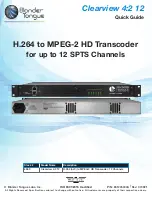
Motor - OH after the bearing is replaced (PeakVue)
Figure 5-8:
5.3
Temperature
The levels at which to set temperature alerts depend on a number of factors including the
specific process, the operating environment, and the characteristics of the equipment
being monitored. This section provides some generic guidelines, given some knowledge of
the variables involved, for setting the thresholds for your specific CSI 9420 installation.
However, the generic methodologies described here are no substitute for first-hand
knowledge of your plant. If, for example, you know that you have problems when a
temperature exceeds a particular value, then set your thresholds accordingly rather than
following these generic guidelines.
In general, the best way to detect a developing fault related to temperature is to look for
an increase in temperature, relative to ambient, over time. This implies that, for reliable
alerting, the thresholds should change as ambient temperature changes. In practice, this
can be difficult to do because it requires the operator to constantly monitor the ambient
temperature and adjust the alert levels accordingly. It is customary, therefore, to pick an
"average" ambient temperature (that is generally seasonal for outdoor installations) and
choose fixed thresholds based on this average. Also, there are issues with this
methodology (such that it does not work well) in areas with large variations in ambient
temperature.
You can select thresholds based on some absolute temperature limit. In practice, this is
much easier to maintain but is not as effective at detecting early failures as relative
monitoring.
Velocity, PeakVue, and temperature
98
MHM-97408, Rev 15
Summary of Contents for CSI 9420
Page 4: ......
Page 10: ...Revision numbers in AMS Device Manager Figure 1 2 Introduction 4 MHM 97408 Rev 15 ...
Page 60: ...PeakVue spectrum Figure 2 35 Configuration 54 MHM 97408 Rev 15 ...
Page 92: ...Setup 86 MHM 97408 Rev 15 ...
Page 134: ...Product certifications 128 MHM 97408 Rev 15 ...
















































